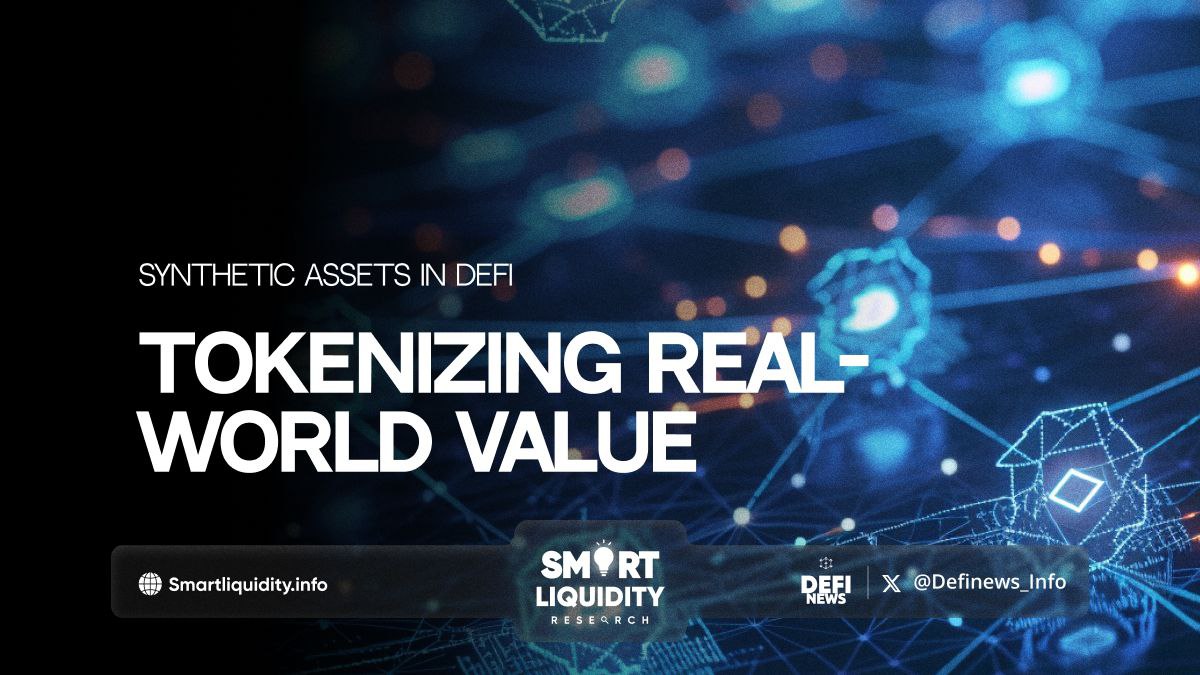Synthetic Assets in DeFi: Tokenizing Real-World Value


Synthetic Assets in DeFi: Tokenizing Real-World Value! Decentralized finance (DeFi) has redefined traditional financial systems by introducing new financial instruments and models, one of which is synthetic assets. Synthetic assets in DeFi have emerged as a groundbreaking concept, enabling the tokenization of real-world value on the blockchain.
This article explores the significance, mechanics, and impact of synthetic assets in DeFi, illustrating how they bridge the gap between traditional finance and blockchain technology.
What Are Synthetic Assets?
Synthetic assets are digital representations of real-world assets, created using smart contracts on a blockchain. These assets can mimic the value and behavior of any underlying asset, such as commodities, stocks, currencies, or even real estate. By tokenizing these assets, synthetic assets enable users to gain exposure to traditional financial instruments without needing to own or manage the actual underlying assets.
For example, instead of buying shares in a company, a DeFi user can purchase a synthetic asset that mirrors the price movement of those shares. This synthetic version is often referred to as a “crypto derivative,” as it derives its value from the real-world asset it represents.
How Do Synthetic Assets Work in DeFi?
The creation and management of synthetic assets are governed by smart contracts. These contracts utilize price oracles, which are services that provide real-time data from external markets, to ensure that the synthetic asset accurately tracks the value of the underlying asset.
Here’s a simplified process of how synthetic assets are created and traded:
- Collateralization
Users lock up a certain amount of cryptocurrency, such as Ethereum (ETH), in a smart contract as collateral. This collateral secures the synthetic asset and ensures its value. - Minting Synthetic Assets
Once the collateral is locked, users can mint (create) synthetic assets corresponding to the real-world asset they wish to replicate. For instance, if a user wants to create a synthetic asset that tracks the price of gold, they can mint a token representing gold using the collateral. - Trading and Liquidity
These synthetic assets can then be traded on decentralized exchanges (DEXs) or used within various DeFi protocols. Liquidity providers can also stake these assets in liquidity pools to earn rewards, further enhancing the ecosystem’s liquidity. - Redemption
If the user wishes to redeem the collateral, they can burn (destroy) the synthetic asset by returning it to the smart contract. This action releases the locked collateral back to the user.
Benefits of Synthetic Assets in DeFi
- Global Accessibility
Synthetic assets democratize access to financial markets by allowing anyone with an internet connection to gain exposure to real-world assets. This global accessibility breaks down barriers that traditionally limit access to financial instruments. - Fractional Ownership
By tokenizing real-world assets, synthetic assets allow users to own fractions of expensive assets, such as real estate or stocks. This fractional ownership model makes it easier for small investors to participate in markets that would otherwise be out of reach. - 24/7 Market Access
Unlike traditional financial markets that have set trading hours, synthetic assets can be traded 24/7 on decentralized platforms. This continuous market access ensures that users can react to market changes in real time. - Cost Efficiency
Synthetic assets eliminate the need for intermediaries, such as brokers or banks, reducing transaction costs and increasing efficiency. The decentralized nature of DeFi ensures that fees are typically lower than those in traditional finance.
Risks and Challenges
While synthetic assets offer numerous advantages, they are not without risks. Key challenges include:
- Price Oracles
The accuracy of synthetic assets relies heavily on the reliability of price oracles. Any malfunction or manipulation of these oracles can lead to inaccurate asset pricing, causing significant losses for users. - Collateralization Risk
The value of the collateral locked in a smart contract must be maintained to secure the synthetic asset. If the value of the collateral drops significantly, the asset may become undercollateralized, leading to potential liquidations and losses. - Regulatory Uncertainty
Synthetic assets, like many DeFi instruments, operate in a regulatory gray area. Governments and regulatory bodies are still grappling with how to classify and oversee these digital assets, creating uncertainty for users and developers alike.
Synthetic assets in DeFi can bridge traditional finance and blockchain with smart contracts, oracle systems, and regulations, offering revolutionary financial potential.
Moreover, as more real-world assets are tokenized, the lines between traditional and decentralized finance will continue to blur, leading to a more integrated and accessible global financial system.
In Summary
Synthetic assets in DeFi represent a significant leap forward in the tokenization of real-world value. Synthetic assets combine traditional financial assets with blockchain technology for increased accessibility, efficiency, and innovation. Understanding associated risks is crucial for maximizing their benefits.
Synthetic assets will play a crucial role in decentralized finance, transforming our perception and interaction with value in the digital era as the DeFi ecosystem evolves.




